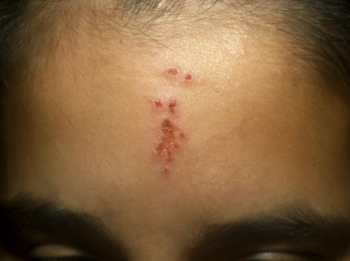
- Consultant for Pediatricians Vol 4 No 10
- Volume 4
- Issue 10
Photoclinic: Cutaneous Calcinosis in a Child With Tertiary Hyperparathyroidism
Photoclinic: Cutaneous Calcinosis in a Child With Tertiary Hyperparathyroidism
An 11-year-old boy who was receiving continuous ambulatory peritoneal dialysis becauseof end-stage renal disease secondary to membranoproliferative glomerulonephritiswas hospitalized with hypocalcemia 2 days after subtotal parathyroidectomy.Before the surgery, multiple lesions were noted on the child's thighs (shown here),upper arms, and abdomen.The lesions, some with calciumdeposits, were hard and painful.A biopsy of the lesions revealed histologicfindings consistent with cutaneouscalcinosis.
Surgery was performed becauseof tertiary hyperparathyroidism--parathyroid hormone (PTH) level of1552 pg/mL--and persistent hypercalcemia(calcium corrected for albuminlevel of 11.9 mg/dL). The preoperativeserum phosphorus level was7.5 mg/dL.
Postoperative laboratory valuesincluded an ionized calcium level of3.45 mg/dL; total calcium, 6.6 mg/dL;albumin, 2.6 g/dL (corrected calcium,7.72 mg/dL); phosphorus,2.6 mg/dL; and PTH, 19 pg/mL.
Nerissa C. Kreher, MD, andEmily Walvoord, MD, of Indianapoliswrite that soft tissue calcificationis a known complication of end-stagerenal disease. High levels of calciumx phosphate product lead to the formationof hydroxyapatite crystalsthat are deposited in the skin and other tissues. Parathyroidectomy decreases PTH levels,thereby decreasing the calcium x phosphate product.
Hypocalcemia after parathyroidectomy is caused by the rapid uptake of calcium by the skeleton,referred to as "hungry bone syndrome." End-stage renal disease initially leads to secondaryhyperparathyroidism because of a combination of hyperphosphatemia and mild hypocalcemia.Tertiary hyperparathyroidism occurs when the parathyroid glands become autonomous as a resultof uncontrolled secondary hyperparathyroidism.
Cutaneous calcinosis often resolves with parathyroidectomy. This child was dischargedafter 5 days, and supplemental calcium (calcium carbonate, 13,500 mg/d) and calcitriol (3 µg/d)were initiated. Three weeks later, the calcifications had diminished and the calcium and PTHlevels had increased.
Articles in this issue
about 20 years ago
Carbon Monoxide Poisoning: Clues to Unmasking the Great Masqueraderabout 20 years ago
Pediatrics Update: Amblyopia Therapy Is for Older Children Tooabout 20 years ago
Tinea Faciei and Tinea Versicolorabout 20 years ago
Photoclinic: Hooked Fingerabout 20 years ago
What’s Wrong With This Picture? Child With Fever and Persistent Coughabout 20 years ago
Photoclinic: Plexiform Neurofibromaabout 20 years ago
Pediatrics Update: Avian Flu: Why All the Squawk?about 20 years ago
Photoclinic: Perianal Streptococcal Dermatitisabout 20 years ago
Photoclinic: Bohn Nodulesabout 20 years ago
Photoclinic: Congenital Melanocytic NevusNewsletter
Access practical, evidence-based guidance to support better care for our youngest patients. Join our email list for the latest clinical updates.









